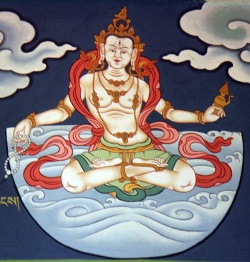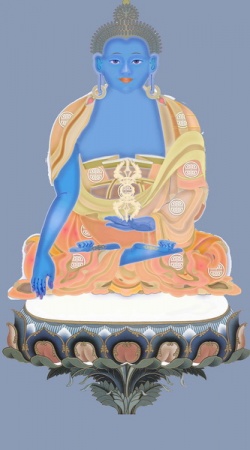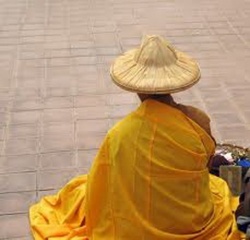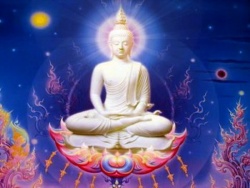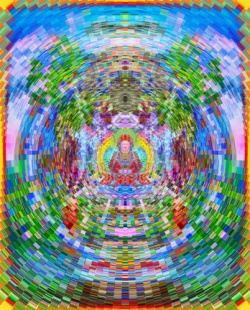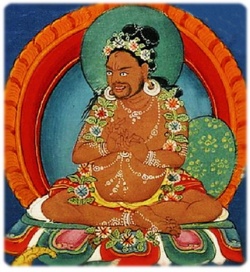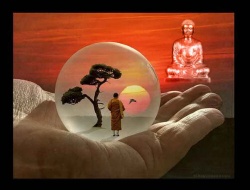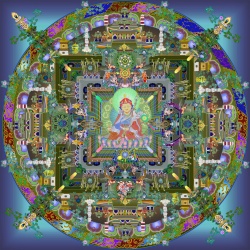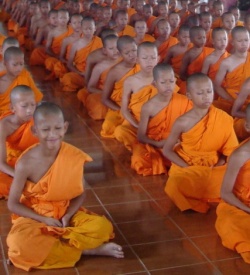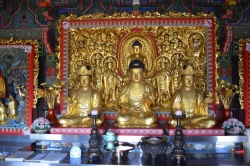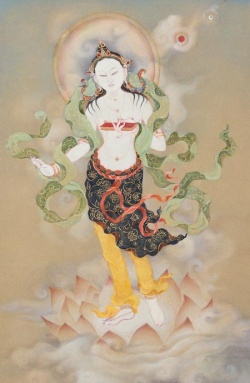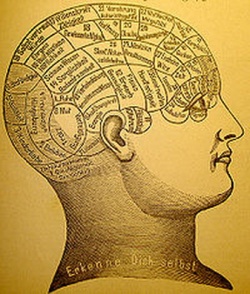Dreaming
Click here to see other articles relating to word Dreaming
Milarepa warned Gampopa that "attention to dreams is an entry way for Mara."
He sings about his student's dream of 24 signs of prosperity:
In the Prajnaparamita of True Meaning
Buddha himself said that dreams are deceptive and are not real.
They are empty, vain, and hollow.
To record, collect and study them brings little gain.
This is why Buddha used dreams as one of the eight parables,
To show the illusory nature of all things.
Haven't these warnings entered your mind?
Haven't these injunctions occurred to you?
And yet, in this case at least,
Your dreams truly were wondrous omens,
Foretelling marvelous things to come in the future!
I, the yogi who has mastered the art of of dreams,
Will interpret their magical meaning for you. ... .
~ 2nd, 3rd and [below] final stanzas in Jampa Mackenzie Stewart's Life of Gampopa (64-68.)
The two verses may seem contradictory, especially in the context of contemporary society for we have another kind of attitude to dreams -- that is, the psychoanalytic approach.
Noble Master, Milarepa, is warning against the notion that there are formulas by which symbols can be read. For example, if we consult a "dream dictionary" we are certain to be misled.
Also, if we try to interpret our own dreams or those of others without being fully aware of the way hopes and fears can influence the dreaming itself, as well as the interpretation, then we are likely to misread which may lead to reinforcement of our erroneous views or behaviors.
It requires experience and knowledge to interpret dreams with the objective of helping to heal a person's "everyday" mind. However, it requires a meditater on the order of a yogi like Milarepa -- one who has knowledge, insight, understanding, and experience of the true nature of consciousness -- to make predictions based on dreaming (or other types of manifestation.)
Since "Some bad omens may appear as good dreams And only an expert can discern their evil meaning . . . ."
But in general, it is harmful
To become too attached to dream interpretation.
No matter what experiences you have,
Whether in dreams or while awake, whether good or bad,
If you cling to them as real, they become an obstacle.
If you know they are illusion you can bring them to the path.
Dream Yoga
"If during the Dream state you direct your awareness and your concentration to the throat, this will make your dreams clearer. Whereas, if you direct your awareness to the heart, then it will make your sleep deeper.
So here is a subjective sleeping pill." ~ The Dalai Lama's Book of Daily Meditations: The Path to Tranquility. Rider Press.
It may be helpful to understand right off that for Buddhists, the primary goal of paying attention to one's dreams has to do with the achievement of the ultimate objective,
Awakening or Liberation, and not with using dreams as a means of motivation, inspiration or prediction.
W. Y. Evans-Wentz' Tibetan Yoga and Secret Doctrines includes Book III:
The Path of Knowledge which comprises the Yoga of the Six Doctrines (dharmas.) Here is an edited version of Chapter Three: The Doctrine of the Dream State.
It consists of four steps or parts: Comprehending, Transforming, Realizing Illusion, and Meditating on 'Thatness' Suchness, or Emptiness.]
Part One: Comprehending [the nature of the Dream-state.]
It consists of three aspects:
Comprehending by the Power of Resolution,
Comprehending by the Power of the Breath, and
Comprehending by the Power of Visualization.
1. Comprehending by the Power of Resolution:
At the 'the initial comprehending of the dream' resolve to maintain an unbroken continuity of consciousness from waking-state to dream-state.
In other words, under all conditions during the day [or waking-state) you hold to the concept that all things are of the same substance as dreams and strive to maintain that attitude even whether awake or asleep.
So at night, when you are about to fall sleep, pray to the Guru that you be enabled to comprehend this nature of the dream-state; and firmly resolve to do so. By meditating in this way, you will comprehend that.
Remember: 'All things result from their causes; they depend entirely upon the resolution of karma.'
2: Comprehending by the Power of Breath
Go to sleep on the right side, as in the Lion's of the Shakyas -- Buddha in Parinirvana final position.
With the thumb and the ring-finger of the right hand, press the pulsing throat arteries; plug the nostrils with the fingers [of the left hand]; and let saliva collect in your throat.
(As a consequence, the dreamer is able to experience dreaming more vividly and so it is easier to see the similarity between the waking and dreaming states.
Also in passing from one state to another, one may experience no break in the continuity of memory.) In that way the content of the dream-state will be found to be quite the same as the content of the waking-state, in that it is wholly phenomenal and therefore illusory... .
Practice 3: Comprehending by Power of Visualization
Includes the visualization itself; and how to derive the greatest benefit from the visualization; preventing the dispersion of the dream-content [both the tendency of dreams to lose their coherence, or to be lost to memory upon waking.]
The Visualization:
Thinking that you are the deity Vajrayogini, visualize in the throat chakra either the Sanskrit or, as here,] the Tibetan syllable AH, red and vividly radiant -- the real embodiment of Divine Speech.
Midway between the heart and that of the throat, in a space about 4 inches long, there is a tube-like psychic-organ;
if the vital force there is quiescent, then sleep ensues but if the force is in motion then dreams occur. Therefore, visualization focuses on that area.
By mentally concentrating on the radiance of the AH, and recognizing every phenomenal thing to be in essence like forms reflected in a mirror which, though apparent, have no real existence of themselves, one may comprehend the dream.
To derive the greatest benefit from the visualization:
At nightfall, [strive to] comprehend the nature of the dream-state by means of the above visualization.
Then at dawn, practice ['vase' or] pot-shaped breathing seven times. Resolve to [or try] eleven times to comprehend the nature of the dream-state.
Then concentrate the mind upon the dot, like a white bony substance, situated between the eyebrows.
(This is mainly to concentrate or focus the attention or produce one-pointedness of mind.) If you are lethargic in temperament, visualize the dot as red; if you are the nervous type, the dot should be green.
If these means do not work and the nature of the dream-state is not comprehended, then do this: At nightfall, meditate upon the dot; in the morning practice twenty-one 'pot-shaped' breathings.
Make twenty-one resolves to comprehend the nature of the dream-state.
Then, by concentrating the mind on a black dot the size of an ordinary pill situated at the base of the sexual organ, you ought to be able to comprehend the nature of the dream-state.
Preventing Loss of Dream-content:
This may be due to a dispersion into the Waking-State,
dispersion because of physical fatigue
dispersion due to physical or mental afflictions,
loss into the Void.
Fading into the waking-state: It occurs when one is just about to comprehend the dream, in view of thinking that it must be comprehended, and then you wake up.
The antidote for this is to eat nutritious food and do some physical work or exercise until you are fatigued. Then your sleep gets deeper; and that should cure the condition.
Dispersion can also occur with repetitious dreams without any change of content.
The antidote here is to meditate often upon the dream and to resolve firmly to comprehend its essential nature.
Do that along with the 'pot-shaped' breathing with the visualization of the dot between the eyebrows.
(This combination of exercises is for better control of the mind, since indomitable control prevents and cures all the various types of dream-content dispersion.)
Dispersion because of some affliction occurs when one has lots of dreams and remembers nothing upon waking. The antidote here is to avoid pollution and impurities, to learn samadhi meditation under a guru, and to visualize the dot as inside the root of the genital organ.
Dispersion into Emptiness refers to there being no apparent dreams.
To overcome this, visualize while meditating with 'pot-shaped' breathing, the dot as being in the root of the generative organ, and also make [real and mental offerings to the Viras and Dakinis.
Part Two: Transmuting Dream-content
The process of transmutation is done as follows:
If, for example, the dream is about fire, think, 'what fear can there be of fire which occurs in a dream?' Holding to this thought, trample upon the fire, ie. stamp out whatever it is that disturbs you.
Once you have practiced doing this in your dreams then turn to the various Buddha Realms [you would know their characteristics from study beforehand, and have faith that they are attainable.]
Accordingly, when about to sleep, visualize a red dot within your throat chakra, and firmly believe that in so doing you will be able to see most vividly, with all its characteristics, whichever of the Purelands you may wish.
But concentrating, you should be able to see the Tushita Heaven, the Happy Western realm, or 'Happy to Know,' or any other of the realms.
This practice serves as the test of efficiency [in the art of transmuting dreams.}
Part Three: Realizing the Dream-state and Its Content to be Illusory
'At the outset, in the process of realizing it to be Maya, abandon all feelings of fear
And, if the dream be of fire, transform the fire into water, the antidote of fire.
And if the dream be of minute objects, transform them into large objects;
Or if the dream be of large objects, transform them into small objects:
That is how one comprehends the nature of dimension.
And if the dream be of a single thing, transform it into many things;
Or if the dream be of many things, transform them into one thing:
[That's how you get to know the nature of plurality and of unity.]
Continue such practices until thoroughly proficient in them.'
Then by visualizing one's own body as seen in the dream-state, and all other bodies similarly seen, as being the Maya-like bodies of deities, they will be realized to be so.
Part Four: Meditating on the 'Thatness' of the Dream-State
The fourth part, requires us 'to meditate upon the real essence of 'Thatness', and in that way those dream propensities, out of which arise whatever is seen in dreams [such] as appearances of deities, are purified.
By concentrating upon the forms of the deities seen in the dream-state, and by keeping the mind in a quiescent condition free of thoughts, then the forms of the deities are attuned to that non-thought condition of mind, and so the Clear Light will dawn whose very essence is the Void [or, Emptiness.]
If one attains mastery of this process, then whether sleeping or awake, one will realize both states [and all their contents] to be illusory, and all phenomenon will be known to be born of the Clear Light.
Niguma's Advice
Niguma, 11th century founder of the Shangpa Kagyu lineage of Tibetan Buddhism, is variously called the consort or the sister of Naropa. She is credited with teaching Dream Yoga, and other liberating techniques in a set of Six Yogas (Nigu Chö Druk.) She said:
Don't do anything whatsoever with the mind --
Abide in an authentic, natural state.
One's own mind, unwavering, is reality.
The key is to meditate like this without wavering;
Experience the Great reality beyond extremes.
In a pellucid ocean,
Bubbles arise and dissolve again.
Just so, thoughts are no different from ultimate reality.
So don't find fault; remain at ease.
Whatever arises, whatever occurs,
Don't grasp -- release it on the spot.
Appearances, sounds, and objects are one's own mind;
There's nothing except mind.
Mind is beyond the extremes of birth and death.
The nature of mind, awareness,
Uses the objects of the five senses, but
Does not wander from reality.
In the state of cosmic equilibrium
There is nothing to abandon or practice;
No meditation or post-meditation period.
~ Miranda Shaw (tr.) "Niguma: Mahamudra as Spontaneous Liberation," in Passionate Enlightenment.
How Buddhist Practice Relates to the Development of "Psychic Powers"
Khenpo Karthar Rinpoche. The Two Accumulations: Merit and Wisdom (32-33) Rinpoche teaches in Tibetan; these are his words as they were translated into English.]
Question: Is there a Buddhist explanation for psychic abilities, especially in regard to precognition?
Rinpoche: We all have psychic ability; it is not something one person has and another does not. However, based on the thickness of our mental obscurations, some are able to experience psychic ability, and some, even though it is present, are unable to experience it.
That is why, through meditation, we "peel off" layers of obscurations.
As the obscurations become thinner, we develop our psychic ability. That ability is called, "supersensitive cognition" in Buddhism, through which we can foresee future events and so forth.
Question: But is there an underlying explanation of these abilities and why they are so different from ordinary reality? And what about precognition? Does that mean that the future is in some sense fixed? If so, how is that possible?
Rinpoche: The underlying explanation is the nature of mind. Psychic ability is a quality of the natural state of the mind. Presently [sic], we let our minds be distracted in so many directions that the natural quality of the mind is not experienced.
That is another way of saying that the development of psychic ability, or super-sensitive cognition, is enlightenment.
In Tibetan, the word for enlightenment has two syllables.
The first is "SANG," which means removal or elimination. In that sense, it means we have eliminated all of the obscurations.
The second syllable, "GYE," means development.
As the natural quality of the mind is developed, psychic ability is one of the natural qualities that are "uncovered."
The subject of whether the future is fixed or not is beyond the capacity of comprehension of our ordinary minds.
At present, our ordinary minds are producing so many thoughts that everything is very much a fabrication of our minds.
That is exactly where the whole subject of wisdom (jnana in Sanskrit) comes in.
The wisdom mind is beyond such fabrication. Therefore, it is able to foresee the future.
For us, we cannot say now whether it is fixed or not, since even such words we use are fabrications of our ordinary mind. There are not accurate words to describe the wisdom involved.
To define something in a way that is free of error, we would have to find words that were free of error, which is not possible.
Question: When you were telling us that if we pray to the higher bodhisattvas, such as Manjushri, for wisdom, does that mean that at some bhumi level we will develop wisdom that is, as you are now saying, not describable in words?
Rinpoche: I was talking about a particular dedication prayer that is done after the Chenrezik practice. In the prayer itself, the names of two bodhisattvas, Manjushri and Samantabhadra (Jampalyang and Kuntuzangpo in Tibetan) are given, but actually, any bodhisattva would be of benefit.
Again, our ordinary minds and activities are too confused to transmute good virtue into wisdom, so we are asking their help. In that way, yes, it is possible.
Question: As we progress along the levels or bhumis, then are we also progressing in terms of wisdom?
Rinpoche: Yes. As we progress along the path of the bhumis, our wisdom also progresses. Finally, we experience the Vajradhara level of realization, the state of Dorje Chang.
The prayer also expresses that by doing this practice of dedication, we can develop and progress in that way.
Cut Down on Conceptualization
Not all experience has to be "food for thought." The Western system of education tends to reinforce thinking about thinking. It encourages the description, comparison, and analysis of experience.
Sometimes a term or a label can arise from this process that lends a reality to something that does not even exist. This process is known as reification.
Consider the notion of "race."
There is absolutely no scientific evidence at all for separate and distinct strains, whether four or a hundred, of human beings, yet the suffering produced by those who cling to the notion is prolonged merely by our repeating the word.
To get in touch with the essential nature -- to experience it rather than just talk about it -- conceptualization has to be abandoned, if only once and a while.
Also, since it is that habit that contributes to our attachments and aversions, we may have to practice noticing when we are conceptualizing in order to rid ourselves of them:
Conceptualization means to have a thought about something.
At least, that is what it means in walking-around English. When we are
talking about Dharma, I think it means to take something that can't be
contained in a thought (or represented by an image or word) and to try to capture "it" there. So "things" (which of course aren't things at all) that
we conceptualize would be like Dharmakaya. Dharmakaya is totally without boundaries and can't be expressed, only experienced. When we try to describe it, even to say it is without boundaries, we are conceptualizing.
Why do we do that? Because we are Human Beings with brains. It is our nature to think, not purely experience. In fact, it is extremely difficult to do that. They say we experience non-conceptually when we sneeze or have an orgasm. ... .
At my Dharma study class tonight (we are reading Shantideva's The Way of the Bodhisattva -- highly recommend it to you all!) we talked about this.
It was said that intense moments of conceptuality (like when we are very
angry, for example) are very helpful to the practitioner because the focus
our mind and show us the state of our minds. It is during moments of
conceptualization that we can't avoid seeing our the true state of our minds.
Later in the evening, we read The 37 Practices of Bodhisattvas. Three verses
stuck out for me.
22. Whatever appears is your own mind. Your mind from the start was free from fabricated extremes. Understanding this, do not take to mind Inherent signs of subject and object- This is the practice of Bodhisattvas.
27. To Bodhisattvas who want a wealth of virtue those who harm are like a precious treasure. Therefore towards all cultivate patience without
hostility - This is the practice of Bodhisattvas.
and then the verse that HE Garchen Rinpoche says sums up the entire 37
practices ...
36. In brief, whatever you are doing, ask yourself "What's the state of my
mind?" With constant mindfulness and mental alertness accomplish other' good - This is the practice of Bodhisattvas.
These are the tools of the Kagyu. Observing our own minds. Conceptualization is the prison, but it is also the key out of prison. HE Garchen Rinpoche has said that we in the Kagyu fight fire with fire. I think this is an excellent example of that!
May we set all prisoners free,
~ Jen, to the Kagyu email list
__________________________________________________________________
race: L. L. Cavalli-Sforza, originator of the Human Genome Diversity Project, "Genetic differences among populations or races, however defined, are small or trivial compared with those within populations." and "The classification into races has proved to be a futile exercise." Genetic research undermines "the popular belief that there are clearly defined races" and the notion of races in the human species "serves no purpose."
reification and the aversion/attachment situation using race as an example: Yale University's Jonathan Marks, "Racism, Eugenics, and the Burdens of History," Yale University, paper presented August 1996 in Rio de Janeiro at the IX International Conference on Human Genetics.

